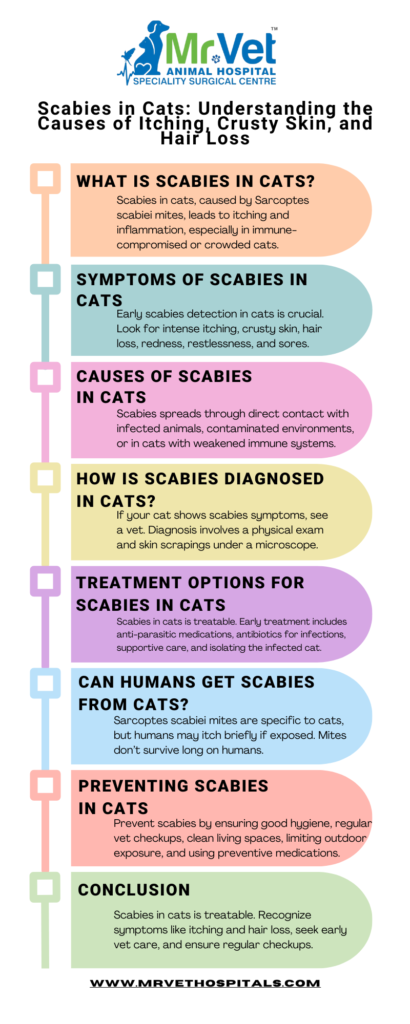
Scabies, also known as feline mange, is a skin condition that can cause severe discomfort for your cat. This highly contagious disease, caused by microscopic mites, leads to intense itching, crusty skin, and hair loss. Understanding scabies in cats, its symptoms, and treatment options can help you take better care of your feline friend.
What Is Scabies in Cats?
Scabies in cats is primarily caused by a type of mite called Sarcoptes scabiei. These mites burrow into the cat’s skin, laying eggs and triggering a severe allergic reaction. This results in symptoms like irritation, itching, and inflammation.
Though scabies can affect any cat, it is more common in those with weakened immune systems, young kittens, or cats living in crowded conditions.
Symptoms of Scabies in Cats
Recognizing the symptoms of scabies early can help prevent its spread and ensure prompt treatment. The most common signs of scabies in cats include:
- Intense Itching – Cats with scabies experience extreme itching, causing them to scratch persistently.
- Crusty Skin – The affected areas may become scaly or crusty, particularly around the ears, face, neck, and legs.
- Hair Loss – Mites damage hair follicles, leading to patchy hair loss, primarily in the infected areas.
- Redness and Inflammation – As the mites burrow, the skin becomes inflamed, resulting in redness and swelling.
- Restlessness – The constant discomfort and itching may cause your cat to become more irritable and restless.
- Scabbing or Open Sores – Prolonged scratching can lead to open sores or scabs, which can further worsen the condition if not treated.
Causes of Scabies in Cats
Scabies is caused by the Sarcoptes scabiei mites, which can be transmitted in several ways:
- Direct Contact with Infected Animals: Cats can contract scabies by coming into direct contact with infected animals. This is common in multi-pet households or outdoor cats who interact with strays.
- Contaminated Environments: The mites can survive in the environment for a short period, so cats may pick them up from bedding, toys, or other objects contaminated by an infected animal.
- Weakened Immune System: Cats with compromised immune systems are more susceptible to scabies because their body is less able to fight off the mite infestation.
How Is Scabies Diagnosed in Cats?
If your cat is showing symptoms of scabies, it’s crucial to consult a veterinarian. Diagnosis usually involves a combination of physical examination and skin scrapings. The vet will collect a sample from the affected area and examine it under a microscope to confirm the presence of mites.
Treatment Options for Scabies in Cats
Scabies in cats is treatable, but it’s essential to start treatment as early as possible to prevent further complications. Common treatment options include:
- Medications – Your vet may prescribe anti-parasitic medications like ivermectin or selamectin to kill the mites. Topical treatments, such as medicated shampoos, creams, or dips, are also effective in eradicating mites.
- Antibiotics – If the scabies has caused secondary bacterial infections due to open sores or scratching, your vet may prescribe antibiotics.
- Supportive Care – Cats suffering from severe irritation may benefit from anti-inflammatory medications to reduce itching and promote healing.
- Isolation – Since scabies is highly contagious, it’s important to isolate the infected cat from other pets in the household to prevent the spread of mites.
Can Humans Get Scabies from Cats?
Though the Sarcoptes scabiei mites that cause scabies in cats are species-specific, humans can experience temporary itching if they come into contact with an infected cat. However, the mites typically don’t survive long on human skin.
Preventing Scabies in Cats
Preventing scabies involves maintaining good hygiene and minimizing your cat’s exposure to other infected animals. Some preventive measures include:
- Regular Vet Checkups – Routine visits to the vet can help identify potential health issues, including scabies, before they become severe.
- Maintain Clean Living Spaces – Regularly cleaning your cat’s bedding, toys, and grooming tools can help eliminate the risk of mite transmission.
- Limit Outdoor Exposure – If possible, keep your cat indoors or limit their interactions with stray or unfamiliar animals.
- Use Preventive Medications – Some preventive treatments like flea control medications can also protect your cat from mite infestations.
Conclusion
Scabies in cats is an uncomfortable but treatable condition that requires prompt attention. By recognizing the symptoms of itching, crusty skin, and hair loss, and seeking veterinary care early, you can ensure your cat gets the treatment they need. Regular checkups, good hygiene, and preventive care are crucial to keeping your feline friend healthy and free from scabies.
If you suspect your cat may have scabies, don’t hesitate to consult MrVet Hospitals for expert care and guidance.

